To be the best, people go to incredible lengths. For example, athletes train tirelessly to beat the competition by a millisecond. Students spend years studying to achieve top academic achievement. Companies or organizations spend decades researching new technologies to solve problems that once only existed in science fiction. And finally—the tech-savvy—power engineers work to develop superbly efficient, high-density converters.
I bet that when most of you fired up your circuits, you achieved at least your personal best in terms of power density and efficiency. You went home and probably enthusiastically described your exciting experience to your spouse or children, only to have them bewildered by your actions.
Rest assured, you won’t get that kind of feedback here. Personally, I like to explore new things and try to make them better than before. TI has a new controller, the UCC256301, that is currently making a lot of noise because it makes power supplies perform really well.
The UCC256301 is the latest in the TI LLC controller family, as shown in Figure 1. Its features and benefits include integrated high-voltage startup, x-cap discharge, robust fault protection, and a new, absolutely reliable control method.
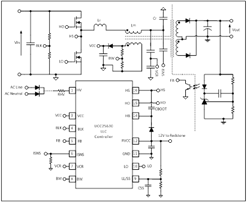
Figure 1: UCC256301 system block diagram
During the competitive product analysis, UCC256301 outperformed similar devices in terms of stability margin, ease of design, powerful protection mechanism, light load efficiency and transient interference suppression.
Now, let's take a look at the following example. I modified a commercial gaming system using the UCC256301. Figure 2 shows the load transient response before and after the modification.
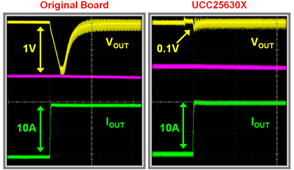
Figure 2: Transient response improvement
The stock board actually performs quite well. However, look at what the UCC256301 does on that! Load transient response becomes less important. For the manufacturer, this could mean a 20% reduction in output capacitance, not to mention other component savings in enhanced performance and integration. The block diagram in Figure 3 illustrates the savings with a different system-level circuit like this device.
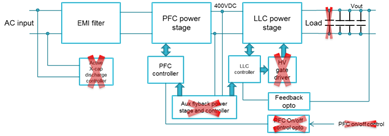
Figure 3: System-level component savings
In the same gaming system, I achieved additional performance improvements in output ripple voltage in burst mode (Figure 4, 10x smaller) and light load efficiency (Figure 5, 10% better efficiency). In another system, I measured less than 40mW of no-load power while fully regulating the output even in the presence of a high voltage power factor correction (PFC) input. To me, this exemplifies the concept of an accelerated device. I tried to tell my wife and kids about this, but they gave me blank looks in return.
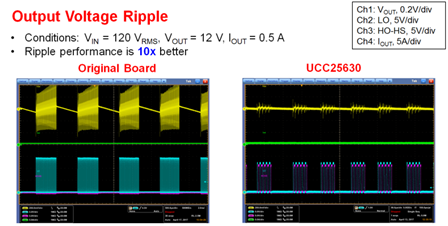
Figure 4: Ripple Lift
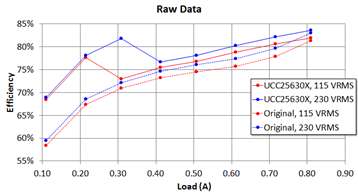
Figure 5: Efficiency improvement
There are many more aspects of this device that could be discussed; however, at its core is a new control architecture called Hybrid Hysteretic Control (HHC). This control architecture combines the advantages of direct frequency control LLC and charge control LLC to achieve a product that is superior to the others. In fact, this control method goes a long way to improving performance.
Previous article:What fried your processor?
Next article:Should the oscilloscope input impedance be 1MΩ or 50Ω?
- Popular Resources
- Popular amplifiers
- Why is the vehicle operating system (Vehicle OS) becoming more and more important?
- Car Sensors - A detailed explanation of LiDAR
- Simple differences between automotive (ultrasonic, millimeter wave, laser) radars
- Comprehensive knowledge about automobile circuits
- Introduction of domestic automotive-grade bipolar latch Hall chip CHA44X
- Infineon Technologies and Magneti Marelli to Drive Regional Control Unit Innovation with AURIX™ TC4x MCU Family
- Power of E-band millimeter-wave radar
- Hardware design of power supply system for automobile controller
- Driving Automation Safety and Economic Engineering
 Professor at Beihang University, dedicated to promoting microcontrollers and embedded systems for over 20 years.
Professor at Beihang University, dedicated to promoting microcontrollers and embedded systems for over 20 years.
- Intel promotes AI with multi-dimensional efforts in technology, application, and ecology
- ChinaJoy Qualcomm Snapdragon Theme Pavilion takes you to experience the new changes in digital entertainment in the 5G era
- Infineon's latest generation IGBT technology platform enables precise control of speed and position
- Two test methods for LED lighting life
- Don't Let Lightning Induced Surges Scare You
- Application of brushless motor controller ML4425/4426
- Easy identification of LED power supply quality
- World's first integrated photovoltaic solar system completed in Israel
- Sliding window mean filter for avr microcontroller AD conversion
- What does call mean in the detailed explanation of ABB robot programming instructions?
- Breaking through the intelligent competition, Changan Automobile opens the "God's perspective"
- The world's first fully digital chassis, looking forward to the debut of the U7 PHEV and EV versions
- Design of automotive LIN communication simulator based on Renesas MCU
- When will solid-state batteries become popular?
- Adding solid-state batteries, CATL wants to continue to be the "King of Ning"
- The agency predicts that my country's public electric vehicle charging piles will reach 3.6 million this year, accounting for nearly 70% of the world
- U.S. senators urge NHTSA to issue new vehicle safety rules
- Giants step up investment, accelerating the application of solid-state batteries
- Guangzhou Auto Show: End-to-end competition accelerates, autonomous driving fully impacts luxury...
- Lotus launches ultra-900V hybrid technology "Luyao" to accelerate the "Win26" plan
- [Raspberry Pi 3B+ Review] Installation Process
- UBLOX M8N module one chip cannot be recognized
- About AGC PDF
- Popular Science: Talking about Carrier Aggregation
- RP2040 Stamp Micro Handheld Terminal
- EEWORLD University ---- MOS Transistor (Columbia University, English subtitles)
- SPMC75F2413A Application Solution
- Domestic M0 chip transplantation FreeRTOS notes 1
- You decide the forum functions! Make a habit of voting by replying to posts!
- Stack Overflow Technology from Entry to Mastery

 AZ4559M-E1
AZ4559M-E1
















 京公网安备 11010802033920号
京公网安备 11010802033920号